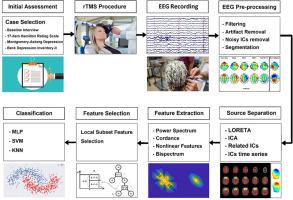Psychiatry Research: Neuroimaging ( IF 2.3 ) Pub Date : 2023-11-23 , DOI: 10.1016/j.pscychresns.2023.111764 Elias Ebrahimzadeh , Amin Dehghani , Mostafa Asgarinejad , Hamid Soltanian-Zadeh

|
Background
Forecasting the efficacy of repetitive transcranial magnetic stimulation (rTMS) therapy can lead to substantial time and cost savings by preventing futile treatments. To achieve this objective, we've formulated a machine learning approach aimed at categorizing patients with major depressive disorder (MDD) into two groups: individuals who respond (R) positively to rTMS treatment and those who do not respond (NR).
Methods
Preceding the commencement of treatment, we obtained resting-state EEG data from 106 patients diagnosed with MDD, employing 32 electrodes for data collection. These patients then underwent a 7-week course of rTMS therapy, and 54 of them exhibited positive responses to the treatment. Employing Independent Component Analysis (ICA) on the EEG data, we successfully pinpointed relevant brain sources that could potentially serve as markers of neural activity within the dorsolateral prefrontal cortex (DLPFC). These identified sources were further scrutinized to estimate the sources of activity within the sensor domain. Then, we integrated supplementary physiological data and implemented specific criteria to yield more realistic estimations when compared to conventional EEG analysis. In the end, we selected components corresponding to the DLPFC region within the sensor domain. Features were derived from the time-series data of these relevant independent components. To identify the most significant features, we used Reinforcement Learning (RL). In categorizing patients into two groups – R and NR to rTMS treatment – we utilized three distinct classification algorithms including K-Nearest Neighbor (KNN), Support Vector Machine (SVM), and Multilayer Perceptron (MLP). We assessed the performance of these classifiers through a ten-fold cross-validation method. Additionally, we conducted a statistical test to evaluate the discriminative capacity of these features between responders and non-responders, opening the door for further exploration in this field.
Results
We identified EEG features that can anticipate the response to rTMS treatment. The most robust discriminators included EEG beta power, the sum of bispectrum diagonal elements in the delta and beta frequency bands. When these features were combined into a single vector, the classification of responders and non-responders achieved impressive performance, with an accuracy of 95.28 %, specificity at 94.23 %, sensitivity reaching 96.29 %, and precision standing at 94.54 %, all achieved using SVM.
Conclusions
The results of this study suggest that the proposed approach, utilizing power, non-linear, and bispectral features extracted from relevant independent component time-series, has the capability to forecast the treatment outcome of rTMS for MDD patients based solely on a single pre-treatment EEG recording session. The achieved findings demonstrate the superior performance of our method compared to previous techniques.
中文翻译:

非线性处理和强化学习预测抑郁症 rTMS 治疗反应
背景
预测重复经颅磁刺激 (rTMS) 治疗的疗效可以通过防止无效治疗来节省大量时间和成本。为了实现这一目标,我们制定了一种机器学习方法,旨在将重度抑郁症 (MDD) 患者分为两组:对 rTMS 治疗有积极反应 (R) 的人和无反应 (NR) 的人。
方法
在开始治疗之前,我们使用 32 个电极进行数据收集,获得了 106 名诊断为 MDD 的患者的静息态脑电图数据。这些患者随后接受了为期 7 周的 rTMS 治疗,其中 54 名患者对治疗表现出积极反应。通过对脑电图数据采用独立成分分析 (ICA),我们成功地查明了相关的脑源,这些脑源有可能作为背外侧前额叶皮层 (DLPFC) 内神经活动的标记。对这些已识别的来源进行了进一步审查,以估计传感器域内的活动来源。然后,我们整合补充生理数据并实施特定标准,以产生比传统脑电图分析更现实的估计。最后,我们选择了传感器域内与 DLPFC 区域相对应的组件。特征是从这些相关独立组件的时间序列数据中得出的。为了识别最重要的特征,我们使用了强化学习(RL)。在将患者分为两组(R 组和 NR 组至 rTMS 治疗)时,我们使用了三种不同的分类算法,包括 K 最近邻 (KNN)、支持向量机 (SVM) 和多层感知器 (MLP)。我们通过十倍交叉验证方法评估了这些分类器的性能。此外,我们还进行了统计测试,以评估这些特征在响应者和非响应者之间的区分能力,为该领域的进一步探索打开了大门。
结果
我们确定了可以预测 rTMS 治疗反应的脑电图特征。最稳健的鉴别器包括脑电图β功率、δ和β频带中双谱对角线元素的总和。当这些特征组合成单个向量时,响应者和无响应者的分类取得了令人印象深刻的性能,准确度为 95.28%,特异性为 94.23%,灵敏度达到 96.29%,精确度为 94.54%,所有这些都是使用 SVM 实现的。
结论
这项研究的结果表明,所提出的方法利用从相关独立成分时间序列中提取的功率、非线性和双频特征,能够仅根据单个预治疗预测 MDD 患者的 rTMS 治疗结果。治疗脑电图记录会话。所取得的结果证明了我们的方法与以前的技术相比具有优越的性能。



























 京公网安备 11010802027423号
京公网安备 11010802027423号